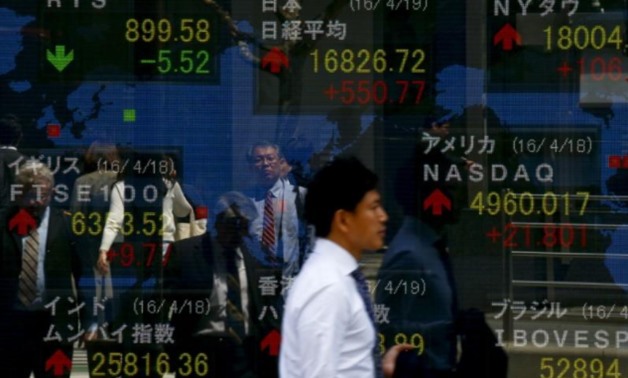
A man walks past a display of the Nikkei average and other market indices outside a brokerage in Tokyo, Japan April 19, 2016. REUTERS/Thomas Peter
LONDON - 23 January 2018: World stocks hit another all-time high on Tuesday, as relief at a temporary U.S. government funding deal boosted already sky-high confidence about global growth and corporate earnings.
New records in Asia and then a solid start for Europe’s major bourses <0#.INDEXE> ensured it was a 12th high of the year for MSCI’s 47-country gauge of world stocks .MIWD00000PUS as its January surge continued.
The International Monetary Fund revised up its global growth forecasts for 2018 and 2019 to 3.9 percent, which would be the highest since 2011. There was also a lift from Japan as its central bank said it would keep its stimulus flowing.
“We should not confuse a mature bull market with a decrepit one,” Goldman Sachs said in its 2018 outlook to clients.
“For the first time in a decade, the major economies of the world are all expanding at the same time, providing a foundation for global profits that fundamentally support risk assets.”
Global borrowing costs also eased as the Bank of Japan’s reassurances in Asia added to the relief that U.S. lawmakers had struck a short-term deal on Monday to fund the government through to Feb. 8.
It resolved what had been a three-day shutdown and pushed yields on 10-year U.S. Treasuries - one of the biggest drivers of world borrowing costs - down for the first time in five days in European trading.
European bonds followed suit with Spain’s 10-year bond yield dropping to a seven-month low at 1.36 percent ES10YT=TWEB to cut its premium to ultra-safe German debt down to the leanest since March 2015. Yields move inversely to prices. [GVD/EUR]
Major currencies stuck to the narrative as well. The dollar edged up against the euro to $1.2233 EUR= though it dipped back to 110.73 yen JPY= having failed to cling on to earlier gains against the Japanese currency.
Some investors are sensing that a recent fall in the dollar to a three-year low may be coming to a close amid brewing concerns over the U.S. stance on global trade policy.
U.S. President Donald Trump slapped steep import tariffs on washing machines and solar panels on Monday, putting a cloud over global trade at a time when its revival has fueled hopes for a stronger world economy.
Trump is slated to give the closing address at this year’s Davos summit of political and business leaders on Friday and some analysts expect him to strike a protectionist stance on trade, which may spark a selloff in emerging market currencies.
“If Trump decides to strike a strong anti-trade stance, it will spark a selloff in global trade-oriented currencies such as the Korean won and the Chinese yuan and eventually weigh on the U.S. dollar as well,” said Viraj Patel, an FX strategist at ING in London.
STERLING EFFORT
The other eye-catching currency market move came from Britain's pound as it topped $1.40 GBP=D4 for the first time since voters there chose back in 2016 to leave the European Union. [GBP/]
It is benefiting from both upbeat UK domestic data and hopes of a favorable post-Brexit deal with the EU. On a year-to-date basis it up 3.5 percent, making it is the best performing major currency, beating even the high-flying euro EUR=EBS.
Data on Friday showed too that currency traders on the Chicago futures exchanges have increased their net long sterling positions - or bets that it will rise - to the highest level in 3-1/2 years.
“Sterling is benefiting from the broad dollar weakness story and the recent data has been mildly supportive,” said Thomas Flury, head of FX strategies, UBS Wealth Management, Chief Investment Office.
Despite the unease over U.S. tariffs, MSCI’s broadest index of Asia-Pacific shares outside Japan .MIAPJ0000PUS rose 0.9 percent overnight.
Australian stocks climbed 0.75 percent and South Korea's KOSPI .KS11 added 1.4 percent. Hong Kong's Hang Sang .HSI scaled a record high, Singapore .STI reached a 10-year top and Japan's Nikkei .N225 rose to a 26-year peak.
The BOJ had maintained its interest rate target at minus 0.1 percent and a pledge to guide 10-year government bond yields around zero percent, which showed it remains firmly in stimulus mode.
It also said “inflation expectations have moved sideways recently,” offering a slightly more upbeat view than three months ago when it said they looked weak.
The BOJ “still remains a step behind other central banks looking to normalize their policies,” said Shusuke Yamada, chief Japan FX strategist at Bank of America Merrill Lynch.
Oil prices rose on Tuesday, lifted by healthy economic growth as well as supply restraint by a group of exporters around OPEC and Russia. [O/R]
U.S. crude oil futures CLc1 rose 0.6 percent to $63.94 per barrel and Brent gained 0.56 percent to $69.42 per barrel LCOc1. Spot gold XAU= tacked on 0.2 percent to $1,336.70 per ounce.
In the virtual currency world, bitcoin was down 4.5 percent on the Bitstamp exchange BTC=BTSP at $10,320.13 following news that South Korea will ban the use of anonymous bank accounts in cryptocurrency trading from Jan. 30.
While it was a widely telegraphed move designed to stop virtual coins from being used for money laundering and other crimes, the step also underscored authorities’ intent to close down avenues for spurious speculation.


Comments
Leave a Comment